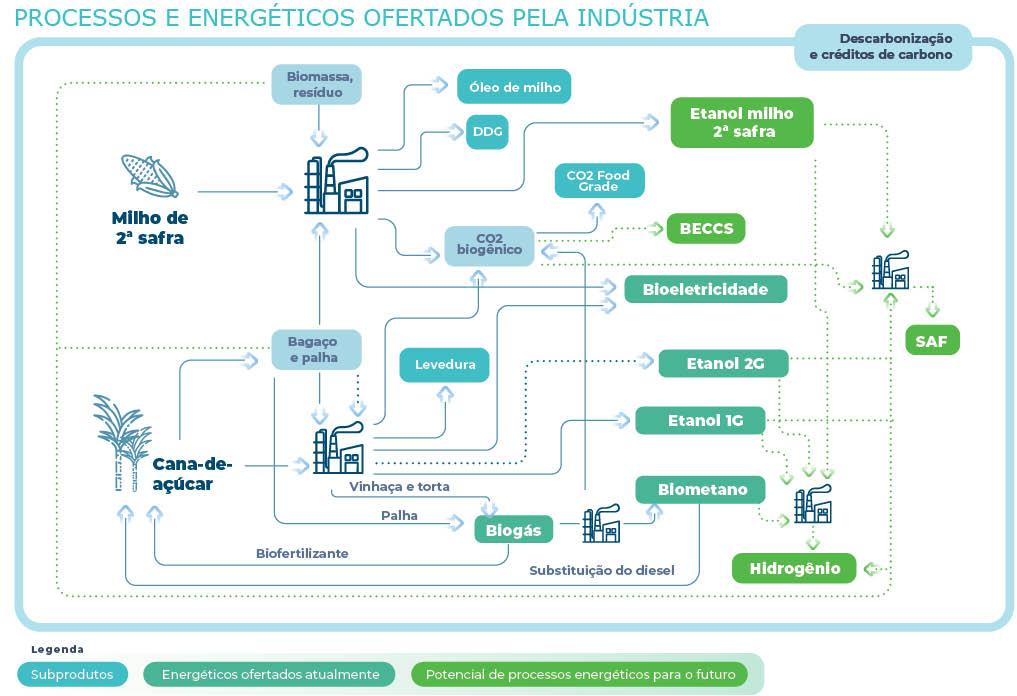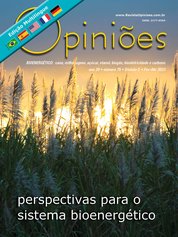Luciano Rodrigues
Diretor de Economia e Inteligência Estratégica da UNICA e pesquisador do Observatório de Bioeconomia da FGV/EESP
OpAA75
Oportunidades para a bioenergia
A humanidade está presenciando transformações importantes em diversas áreas da sociedade. Digitalização, inteligência artificial, telemedicina, engenharia genética, entre outros movimentos, se aceleraram nos últimos anos, especialmente no período pós-pandemia. Dentre essas mudanças, estão aquelas associadas à transição energética e à circularidade dos negócios e dos sistemas de produção.
A transição energética se caracteriza pela necessidade de ampliar a oferta de energia com menor emissão de gases causadores de efeito estufa (GEE).
Essas diretrizes devem ser atendidas com maior eficiência, mudanças nos padrões de consumo e substituição das fontes fósseis por combustíveis renováveis de baixo carbono.
A economia circular, por sua vez, ganhou notoriedade a partir do trabalho seminal de David Pearce e Kerry Turner no início da década de 1990. Em linhas gerais, ela preconiza a substituição da economia linear, baseada na extração produção, utilização, descarte –, por um sistema econômico que prioriza a preservação e o aprimoramento do capital natural, a otimização de recursos e a administração dos estoques finitos dos produtos renováveis. Conceitos como reutilização, reciclagem e regeneração constituem princípios básicos da economia circular.
Essas macrotendências mundiais devem nortear a dinâmica de consumo, as estratégias empresariais e as políticas públicas em várias áreas da economia nos próximos anos. É nesse contexto que a indústria da bioenergia pode se posicionar de maneira efetiva diante das oportunidades criadas por esse movimento global.
A indústria sucroenergética, que há dez anos ainda presenciava discussões sobre o término da queima da palha da cana-de-açúcar, está se reinventando, com mudanças importantes no sistema de produção, no portfólio de produtos ofertados e na qualidade ambiental dos energéticos comercializados. No passado, a lógica da produção agrícola como fonte de alimentos foi inicialmente transporta com a fabricação do etanol a partir da cana-de-açúcar. Nas últimas duas décadas, a bioeletricidade fabricada a partir da palha e do bagaço da cana se consolidou como um novo produto exportado pelo setor.
Hoje, além do etanol de cana e da bioeletricidade, essa indústria conta com a produção de etanol de milho de segunda safra, de etanol de segunda geração, de biogás, de biometano e de créditos de descarbonização. Trata-se de um crescimento expressivo no portfólio de energéticos em apenas uma década. Isso sem contar os inúmeros subprodutos gerados, como é o caso da levedura seca, do óleo de milho, do CO2 biogênico e do DDG, por exemplo.
Essas mudanças também permitiram ajustes no sistema de produção, ampliando a característica de circularidade dos parques de bioenergia. A vinhaça, que era tida como um problema, passou inicialmente a ser utilizada na lavoura com aplicação controlada por aspersão, migrando, em muitos casos, para um sistema de aplicação localizada e, nos últimos anos, garantindo a produção de biogás e biometano antes de retornar ao campo. O gás produzido nesse sistema é utilizado para substituir parte do diesel consumido no processo produtivo.
Esse é apenas um dos inúmeros exemplos da utilização dos resíduos industriais para ampliar a qualidade e o número de energéticos dessa indústria.
No futuro próximo, podemos vislumbrar novos avanços importantes. O CO2 obtido na fermentação do etanol e na purificação do biogás poderá ser alocado no subsolo, a partir de projetos de captura e armazenamento de carbono (projetos de BECCS, da sigla em inglês), permitindo balanço negativo de CO2 na indústria do etanol.
A fabricação de combustível sustentável de aviação (SAF) a partir de etanol pela rota ATJ (alcohol-to-jet), ou a partir da biomassa pela rota FT (Fischer-Tropsch), também pode trazer oportunidades efetivas ao setor.
De acordo com a Associação Internacional de Transporte Aéreo (Iata, na sigla em inglês), serão necessários 450 bilhões de litros de SAF para que o setor aéreo alcance as metas de descarbonização previstas para 2050. Além das metas nacionais e voluntárias de redução de emissões na aviação, a resolução do Icao, uma das agências das Nações Unidas, definiu que as emissões de GEE do setor se estabilizem nos patamares observados em 2019 e criou o Mecanismo de Redução e Compensação de Emissões da Aviação Internacional (Corsia, na sigla em inglês), com reduções mandatórias a partir de 2027.
Além disso, a produção de hidrogênio com energia renovável a partir da reforma do etanol, ou com o uso do biogás, também pode ser vislumbrada pela indústria da bioenergia no futuro. De fato, hoje, temos plantas com eletricidade renovável, etanol, biogás e CO2, que podem ser utilizados como insumo para a produção de SAF e hidrogênio (figura em destaque).
Cabe ainda destacar que a produção brasileira de biocombustíveis já possui pegada de carbono auditada graças às exigências do RenovaBio, permitindo a aferição adequada do potencial de descarbonização de cada planta industrial, garantindo, com isso, a geração de créditos de descarbonização ou CBios.
Em síntese, a despeito das turbulências políticas, regulatórias e de mercado, o setor apresentou avanços importantes na última década e possui enorme potencial para se posicionar na vanguarda de um movimento mundial irreversível.
Precisamos de aperfeiçoamentos nos marcos legais e no ambiente regulatório, garantir previsibilidade e manutenção das regras criadas, valorizar o potencial de descarbonização da bioenergia, investir em comunicação e disseminar o sistema brasileiro para outras regiões do mundo com condições semelhantes. Por fim, o setor produtivo precisa manter os esforços para ampliar a eficiência energética e ambiental na conversão de luz solar em biomassa e em energéticos renováveis de baixo carbono.





